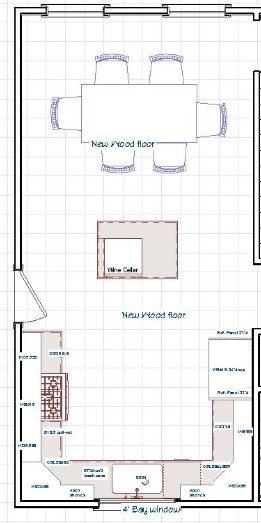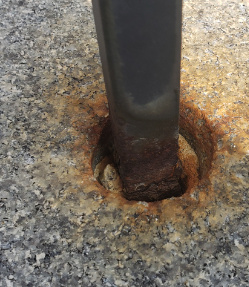I tightened it pretty forcefully by hand and I don’t think I have any wrenches that would fit on it. I’m sure I could get one but is there some kind of torque limit I should worry about? Seems like it’s prone to cracks if I overdo it.
I tighten those as much as I possibly can by hand, to the point that I usually need channel locks to untighten them. PVC is pretty soft at room temperature and you’re not going to crack it unless you’re really cranking it down with a large pipe wrench.
It may not be seated right, or there might be a burr or something on the flange. You can try removing it to make sure the joint looks clean and reset it. It shouldn’t be tweaked or stressed in any direction. You’ll want to gently snug up both the trap joint and the one at the disposal arm first to make sure it’s positioned well before you really tighten down the fittings.
It’s just space to walk between the kitchen and dining room on either side of the island. But I’m wondering if I’m forcing this and should forget about it.
I wouldn’t go any wider. Doing so is going to create awkward corners to walk around between the kitchen and dining area. You’ll be constantly bumping into them and hating them.
Thanks for the feedback. I might just scrap the island then. It involves taking down a load bearing wall so has some costs associated with it, and unless I can get exactly what I want from it then it’s probably not worth the money.
Update on the cracked waste pipe. The plumbers ended up replacing two long sections of iron pipe, and had to make a big hole in the floor above (masonry, part of a white brick hearth) to get at an elbow inside the wall/foundation/beam area. It cost a lot, and I’m realizing that the other repairs are also going to cost a lot. Does anyone know if a cracked pipe like this is covered by insurance, and if so, can I make a claim this far after the incident?
Seems to have been the case. Half the places I called trying to get competitive quotes haven’t called back, and a few that did either want to charge to come out and give an estimate, and/or they are booked out into next spring already. This is a very strange “recession” compared to every other recession I’ve experienced.
Years ago I put new granite steps and landing at my front door and had custom wrought iron railings installed. The granite place drilled holes for the railing footings, and when the railing guy came to put the railings in he used something to fill the extra space in the holes. Well about 12 years later and the elements are eating away at whatever he used to fill up the holes. Anybody have any idea of what I should use to fill these holes in again before the railings come loose? (Hopefully something that looks reasonably close to natural granite.)
bump, anyone?
My only thought was epoxy that’s used to fill concrete cracks, but it wouldn’t look at all like granite. You could get some pebbles and use them like icing.
@JohnnyTruant is there some sort of mid-span brace missing maybe? Or some other edge support? If not, you just got crappy filters, I think.
@anon10387340 I think I’d need a picture to answer with any confidence. The way you’re describing it is a situation that would usually either be done with epoxy or anchoring cement. If it’s gotten weathered to the point of breaking down, I’d guess it’s the latter and that you put a lot of salt on your steps.
I’ll try to remember to get a picture tomorrow. But I definitely don’t put much salt on my steps. They face south and usually dry up quick after every storm. And they hardly ever get used anyway. My side entry I need to salt the hell out of.
I don’t have an answer for you, but a few years ago we got a metal intake filter and are really happy we did. Every now and then we take it out and rinse it in the tub with the hand-held shower head, let it drain for a while, and put it back.
Yeah, that doesn’t look great. Hard for me to tell with such a tiny picture, but that much rust might be cause for concern. I assume getting the railing completely out would be a major undertaking.
- Get as much of that rust off and out of there as you can, and any loose cement
- Optional - Clean the rust stains off the granite with muriatic acid, and see if you can get some more rust off the steel with it too. Make sure to rinse everything down well after.
- Paint the bottom of the rail post with rusty metal primer, then top coat with flat black
- Fill the hole with anchoring cement, being sure to read the instructions and have your shit together. It sets up very fast.
- You want the top of the cement to be above the granite so you don’t get more puddling there. That’s what’s causing the problems. The stuff is pretty soupy so you won’t be able to get it much higher, but all you need is enough for water to drain off it.
Muriatic acid and anchoring cement are both available at any big box store. The acid isn’t as scary as some people make it sound, but it can be a bit stingy. Wear gloves.
I’m not sure this is a home improvement topic, but I thought it would be interesting to some people here:
https://dengarden.com/misc/The-Pitfalls-of-an-Underground-House
I had never really thought about it, but I’m now convinced that I’ll never buy an underground house.
I’ve only skimmed about a third of the article and I can’t handle this many lulz before lunch.
Would be seriously interested in hearing your and others’ thoughts about this particular house and its issues, as well as the general desirability/potential for underground houses.
In a world where basements exist, it doesn’t seem that hard to imagine what an underground house is like.
That article seems to cover it all pretty well. Lots of problems, no clear benefits, only appeals to crazy people who seem blissfully unaware of how crazy they are.
re: microbet’s comment, in every house with a basement I’ve ever been in, the basement is the most unpleasant part of the house.

